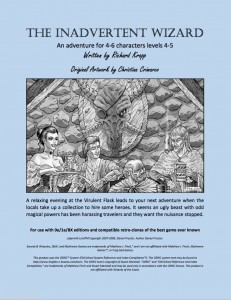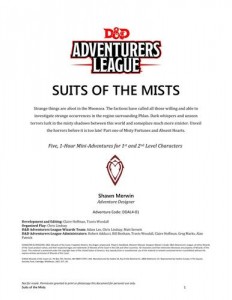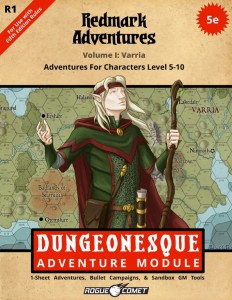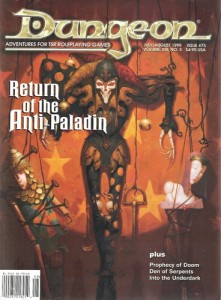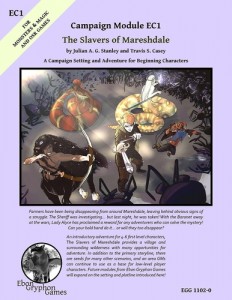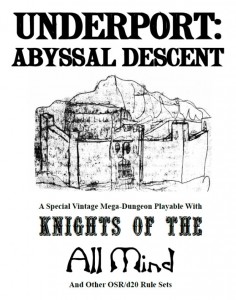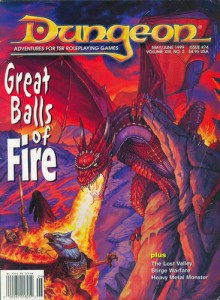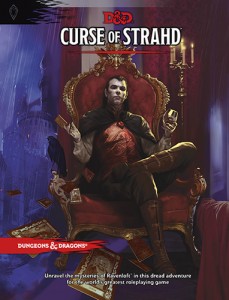
by Jeremy Crawford,Tracy Hickman,Laura Hickman,Adam Lee,Chris Perkins,Richard Whitters
WOTC
D&D 5E
Levels 1-10
Under raging storm clouds, the vampire Count Strahd von Zarovich stands silhouetted against the ancient walls of Castle Ravenloft. Rumbling thunder pounds the castle spires. The wind’s howling increases as he turns his gaze down toward the village of Barovia. Far below, yet not beyond his keen eyesight, a party of adventurers has just entered his domain. Strahd’s face forms the barest hint of a smile as his dark plan unfolds. He knew they were coming, and he knows why they came — all according to his plan. A lightning flash rips through the darkness, but Strahd is gone. Only the howling of the wind fills the midnight air. The master of Castle Ravenloft is having guests for dinner. And you are invited.
This is a retelling of the original I6 Ravenloft adventure, both expanded and and harkening back to the old adventure. Previous WOTC 5E adventures have been almost afraid of providing gameable content. They have provided this kind of generic detail that has been both uninspiring and irrelevant. This don’t do that. It provides some interesting environments to game in and some genuinely spooky shit. In some respects it meets or rivals the spookiness in one of the best horror adventures of all time: The Inn of Lost Heroes. It’s a little more visceral in this adventure, at least in places. It’s sets up some nice places to play in, especially the villages, and does a decent job with the imagery in many of the encounters. Again, in some ways it does a better job bringing things to life than Phandelver. Phandelver is still the best WOTC 5E product though because Phandelver is PLAYABLE. You can crack is open and play it. Curse of STrahd requires reading. A LOT of reading. And note taking. A LOT of note taking. And photocopying. A LOT of photocopies. It also needs about 75% of the text trimmed out of it. Yes, that’s right: 75%. AT LEAST.
Some parts of this adventure are REALLY good. They rip at you and I dare say they are best examples yet of what DREAD is supposed to be. One of the first areas is in an appendix, meant to get the characters from Level 1 to Level 3, Death House (this might be a free download. If so I encourage you to check it out to see what I’m referring to.) The Children in this house were locked away in room 20 in the attic, starved to death by their parents. The window is bricked up. There are two small skeletons huddled in the middle of the floor, one clutching a teddy bear/doll, with a sad little toybox and dollhouse nearby. Holy Shit! This is WOTC and/or Adventurers League?!? It’s very good. There are other scenes in the same adventure, such as the crib draped in tattered/aged black veils, with a swaddled bundle in black in it.When you unwrap it, it’s empty. There’s also the classic “storage room full of mirrors and dress mannequins covered in sheets” room. These are all quite nice and in the case of the children, quite moving and/or visceral.
There are other examples as well, in a similar vein. There’s some hags that literally grind the bones of children to make “dream pastries” to hook people on for escapism. They have an old rain barrell that they use for scrying. If they rap on it three times then a dretch can be summoned, hauling itself out of the barrell. That’s very good. It demonstrates a basic understanding of the shared heritage of what a Hag is and then builds upon it. There’s enough here to get quite inspired.
There are bits and pieces of this sort of excellent adventure/encounter design all over the adventure, much more so than any other WOTC/5E adventure, including Phandelver. They are to be applauded for those bits. From the deep scratches on the doors and windows of Barovia to the woman mad with grief to the priests who’s trapped his undead son in the basement, there are some very good things going on in Barovia. Nice job Strahd!
The villagers and places, in particular, seem more alive than they have in many other WOTC/5E adventures, or in many other adventures period. There are multiple people in each village who all have something going on with them. Each with their own personality. We’re not talking Pembrooktonshire here, but they are certainly a more interesting lot than has I recall ever appearing in any WOTC/TSR adventure, or most others for that matter. It’s not just one plotline, or two, but several. This is then augmented by many of the locations having events. Things HAPPEN in this adventure. People are not just waiting around. Parades of ghosts, vampire attacks, almost every location has one or two events to augment and/or enhance some of the plotlines in the village. This is REALLY good. It brings the place to life. No longer static many of the villages now feel alive in a way they seldom have before in a WOTC product.
Finally, let me comment that some of the art is quite nice. I don’t usually comment on art unless it sets the mood exceptionally well, and it usually doesn’t. In particular there’s a piece on the Gates on Barovia that does a wonderful job of setting the mood of what’s to come. And on the downside I think every picture of Strahd proper is forgettable or laughably bad.
Hmmm, no, one more thing before I move on to the bad. The monsters here are … almost good? The vampire spawn crawl on the ceilings. The hags are haglike. The spectres in the Death House adventure are provided an environment in which they can come to their full potential. You can imagine, from the descriptions of the setting and the monster, how they could be used to appear and attack and so on. IE: The DM is inspired by many of monster texts. That’s exactly what the fuck EVERY adventure should do. There’s also a few near misses. Again, Death House there’s a door that comes alive and sucks the party in. The adventure says something like “the door is a mimic.” Let me suggest that there is a world of difference, in inspiring a DM, between “the door is a mimic” and the door comes alive and reaches out and tries to suck the party in. Treat it as a mimic.” The first is boring old book shit. The second gives the DM a shortcut to running a bizarre encounter by referring back to some 5e rules. There are multiple places in the adventure in which this comes up, this … “wouldn’t it be cooler if I did X … and I can just use these stats to replicate that.” It is at least close enough that this comes to mind, even if I would see it reinforced a little more.
On to the bad. I find myself wanting to make excuses for the adventure. I want to place the blame on Pay Per Word or on some set of Writer’s Guidelines that had to be followed. I’ve got no basis for any of that, but I seem compelled to find the reason for the suck. Maybe because the non-sucky parts are at times very good?
The read-aloud in this, in many places, is laughable. Here is an example: “You stumble upon an old grave.” Or another: “You find a corpse.” Or another: “The bundle contains one set of common clothes sized for a human adult.” Or “You hear the howls of a wolf some distance away.” This is meaningless dreck. If you’re not going to make an effort then it should have been eliminated and no read-aloud provided. Certainly other parts of the adventure provide no read aloud, so why here? Oh wait, oh wait! Here’s a masterpiece of creative read-aloud writing!!! “You find something on the ground.” What the FUCK is up with that? PPW? Style Guide demanding read aloud for every wandering monster entry? And for the record these ARE for a wanderers table, but the read aloud in other places is just as drivel-full. Nonsense, but important because …
In other places the text is long/meaningless in different ways. Rooms are described in detail for the DM. Detail that is meaningless and has no impact on the game. I THINK the writer is trying to set some ambiance, trying to inspire the DM to communicate a creepy vision to the players. But it all becomes Wall of Text. The entries are so long that the important bits are lost. Even the inspiring bits are then lost. Three sentences are used when one will do. Six are used when it needed two, or three. This is one of the major sins of the adventure. There is so much text provided that instead of being inspired you are lost in it all. It’s impossible to run with the book open in front of you. You’re going to have to prepare notes ahead of time and/or highlight the shit out of the adventure in order to run it at the table. And, after all, that’s what this thing is supposed to do, right? Be run at the table? The PLAYABILITY of the text suffers. It’s unfocused.
Back to playability: there’s no overview. Oh, there’s the “Strahd wants his babe back” and the whole “random special object” section up front, but there is nothing beyond yet. It’s clear that each section is meant to tie in to the other locations, I suspect in order to get the characters on the road and roaming around, experiencing the mini-region around the castle. Recall that I mentioned that each of the areas has a lot going on, socially. Lots of little mini-plots. It is, for the most part, these things that hook into the larger region. In Death House you find the deed to w windmill nearby. There’s also an old woman selling sweets in the street. Someone wants you to escort Strahd’s babe to a certain safe place. And so it goes. A leads to B leads to C. But the only way to get an understanding of this is to read the book THOROUGHLY and take a lot of quite focused notes with this purpose in mind. There’s no orientation to the adventure for the DM. “Sandbox” is not an excuse. There’s clearly some things meant to be worked in and the adventure as a whole suffers from not having an overview of how these things fit together.
The locations, particularly the social one such as villages and their ilk, suffer a lot from not having a summary/cheat-sheet. The major NPCs, a couple of words on personality to jar to DM’s memory, a sentence per plot, and so on. A concrete example? I’d love to! Page 26 has a brief overview of what everyone in Barovia knows about what’s going on. You’re going to have to refer back to this incessantly while running almost every social interaction in the book. Similarly, some of the villages have a section like this. You’re going to have to refer back to it, digging through the book. “Uh, hang on, let me find the page, it’s around here somewhere …” It’s lame. You know what you do get? A giant tear out poster in the back of the book. It’s fucking useless. It’s not a DM play aid it’s an art piece. It’s far too large to use during play and it shows the floor plans and layout for the the locations. Hang it on your wall, use it as a marketing piece for the artists who’s hawking his hi-res maps, independently, but it’s fucking useless for the DM. Had that section instead been one page per social location and a brief list of rumors/information and/or an overview flowchart then it would have been MARVELOUS. Seriously, I’m starting to think that no one at WOTV involved in this thing has ever run a game. You’re going to seriously make the argument that the poster map is useful during play? Really? Or that reference sheets wouldn’t have been more useful?
I always feel like I’m walking a fine line between a critique and second guessing. Maybe it’s appropriate, maybe not. I’m a hypocrite though, so let’s talk Hooks & Railroads. The hooks in this are shitty. Just terrible. Strahd sends someone with a fake letter to get you in, both in Version A and Version B or “Strahd lures the tools in.” Then there’s the ever popular. “Mists surround you. You’re in Ravenloft.” You know, the one where the designer doesn’t even try at all. The only one with any promise at all “Werewolves in the Mist”, where werewolves comes out the mists of a forest to raid and steal children. This is the Adventurer’s League hook, and comes with some factions rumors along with it. The whole werewolves coming out of the mist to kill and kidnap is very imagery, it’s too bad that it’s all abstracted. I suspect that the opening read-aloud paragraph is somehow meant for a 4-hour con-game slot and not a 250 page campaign book. Too bad, expanding on this just a bit, even to the point of eliminated the other lame ass “Strahd manipulates you into coming” hooks would have been a much better use of the words. On a related note, the railroads in this are few and far between, which is a VERY good thing. And when they do show up they are ABSOLUTELY TERRIBLE. Strahd Knows All. Strahd Manipulates All. Strahd blah blah blah testing you blah blah blah forces you to blah blah blah. The whole Omniscient and Omnipotent being manipulating you and testing you thing has NEVER been a good hook. EVER. It is only a crutch for a weak writer taking a shortcut. I’m surprised to not see the Strahd Christmas Episode. “The Mists! The Mists!” “They surround you. They close in! Better go where I want you to go or I will kill you!” Lame. Boring. Not. Even. Trying.
Unrelated to the adventure, let me complement the designers on the Character Options presented in the book. This is, essentially, a replacement background that can be used instead of the boring ones in the PHB. Some of the other adventures have tried to include these also, however I’ve found them as boring and lame as the ones in the PHB. Not these! As A Haunted One you get things like: “A hag kidnapped you and raised.” or “A fiend possessed you as a child.” The ten harrowing events are almost all not just good but GREAT. “A monster that slaughtered dozens of innocent people spared your life, and you don’t know why.” THESE are the hooks that myths are made from, not the generic crap in the PHB. These get your mind working. You immediately want to come up with the specifics of what is going on. Similarly, the Gothic Trinket Table. “A winter coat stolen from a dying soldier.” or “A picture you drew as a child of your imaginary friend.” Great great stuff. Not the same old boring genericism that usually comes with official D&D products.
And on the “WOuldn’t it be nice” front, I think some more examples of how a less god-like Strahd interacts with the party would be nice, as well as some more examples of Dread. There’s a little bit of both of these present but I think a few more and/or different examples would be nice. The Strahd stuff seems to focus on his attacking the party. A list of 10 of examples of ways he interacts would have been welcome, especially is a non-combat setting. Similarly, there are some examples of inspiring Dread. Describing wood as rotten, mildew, etc. This would have been an excellent idea for a list of 10 things to put on top of a DM screen or reference sheet, all present to help remind the DM to add that certain style of flavor.
You can find a copy of the Death House adventure at:
http://media.wizards.com/2016/downloads/DND/Curse%20of%20Strahd%20Introductory%20Adventure.pdf
This is the Adventurers League version of the one in the back of the book, meant to get the characters from first level to third, so they can then start the “main” adventure. It differs a bit, but not enough to matter and can serve as an excellent reference to some of the points I’m making. It’s a dungeon, rather than a social location, so the mini-plots and personalities of the people won’t be present in this, but some of the other positives and negatives will be.
The last paragraph of page 3:
“The Mists” are a crappy plot/hook device. There are better ways to do this, even if you want to use the classic Ravenloft mists.
Room 2 (Main Hall) on Page 4:
Note the length of the description for this. It’s trying to set up some ambiance but it’s using so many words/sentences that it’s quite hard to run during actual play. You have to read, instead of glance. Fewer words and a more opulent use of language would have been better in this description, and in many of the other descriptions. The extra stuff adds little gameable content.
Room 6 (Upper Hall) on Page 5:
The armor description is the second sentence is in the last paragraph on the first column. “has a visored helm shaped like a wolf’s head.” I’m always harping on how treasure should be less abstracted and book-like and make the PLAYERS want it. This is a good example of that. just that second clause, about the wolfs head, will make almost every player finding it drool over it.
Room 9 (Secret Room) on page 5/6:
AT the top of page ten the chest is described. It’s a good description and the body hanging out of it is a very nice example of the extra “good” detail adding a lot to the ambiance. Again, the entire room thing is WAY too long and spoon-fed, but the core idea is a very good one.
Room 15 (Nursemaids Suite) on page 7:
As a DM, reading this, I had a very strong visual image of the nursemaid attacking through the stained glass door between the main bedroom and the nursery. The description of the spectre, in one sentence is very good. That is an example of doing a description right and inspiring the DM. Note also the last paragraph of the main room description. The crib with a black shroud/swaddled bundle is a very nice example building tension and dread and, like the body in the chest, is a great element for the room … even if it could use tighter writing.
Room 20 (Children’s Room) on Page 7 and 8:
A core room so it’s allowed to be longer, but it’s still too long. The last two sentences of the first paragraph, describing the children’s bodies, is GOLD. Pure GOLD. The doll house having the secret doors shown is great also and a good example of integrating secret and knowledge into an adventure … for people that pay attention and try harder. Finally, the examples of how to run Possession by the Ghosts, at the top of page 9, are quite nice shortcuts to get a decent little effect but still allowing the players to run their character.
